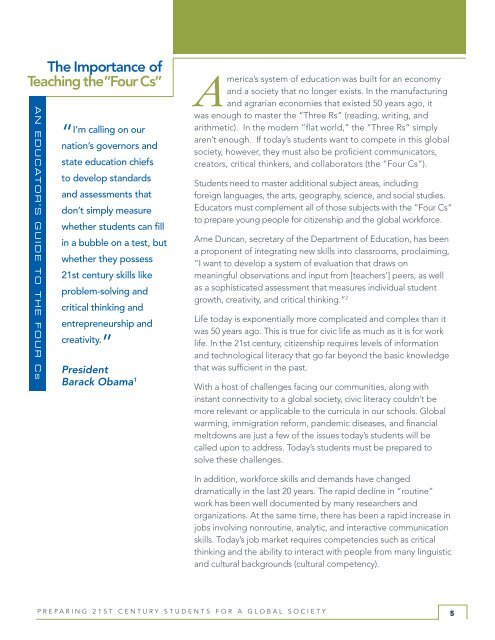Preparing 21st Century Students for a Global Society
Preparing 21st Century Students for a Global Society
Preparing 21st Century Students for a Global Society
Create successful ePaper yourself
Turn your PDF publications into a flip-book with our unique Google optimized e-Paper software.
The Importance of<br />
Teaching the “Four Cs”<br />
A n E d u c At o r ’ s G u i d E t o t h E F o u r c s<br />
“ I’m calling on our<br />
nation’s governors and<br />
state education chiefs<br />
to develop standards<br />
and assessments that<br />
don’t simply measure<br />
whether students can fill<br />
in a bubble on a test, but<br />
whether they possess<br />
<strong>21st</strong> century skills like<br />
problem-solving and<br />
critical thinking and<br />
entrepreneurship and<br />
creativity. ”<br />
President<br />
Barack Obama 1<br />
America’s system of education was built <strong>for</strong> an economy<br />
and a society that no longer exists. In the manufacturing<br />
and agrarian economies that existed 50 years ago, it<br />
was enough to master the “Three Rs” (reading, writing, and<br />
arithmetic). In the modern “flat world,” the “Three Rs” simply<br />
aren’t enough. If today’s students want to compete in this global<br />
society, however, they must also be proficient communicators,<br />
creators, critical thinkers, and collaborators (the “Four Cs”).<br />
<strong>Students</strong> need to master additional subject areas, including<br />
<strong>for</strong>eign languages, the arts, geography, science, and social studies.<br />
Educators must complement all of those subjects with the “Four Cs”<br />
to prepare young people <strong>for</strong> citizenship and the global work<strong>for</strong>ce.<br />
Arne Duncan, secretary of the Department of Education, has been<br />
a proponent of integrating new skills into classrooms, proclaiming,<br />
“I want to develop a system of evaluation that draws on<br />
meaningful observations and input from [teachers’] peers, as well<br />
as a sophisticated assessment that measures individual student<br />
growth, creativity, and critical thinking.” 2<br />
Life today is exponentially more complicated and complex than it<br />
was 50 years ago. This is true <strong>for</strong> civic life as much as it is <strong>for</strong> work<br />
life. In the <strong>21st</strong> century, citizenship requires levels of in<strong>for</strong>mation<br />
and technological literacy that go far beyond the basic knowledge<br />
that was sufficient in the past.<br />
With a host of challenges facing our communities, along with<br />
instant connectivity to a global society, civic literacy couldn’t be<br />
more relevant or applicable to the curricula in our schools. <strong>Global</strong><br />
warming, immigration re<strong>for</strong>m, pandemic diseases, and financial<br />
meltdowns are just a few of the issues today’s students will be<br />
called upon to address. Today’s students must be prepared to<br />
solve these challenges.<br />
In addition, work<strong>for</strong>ce skills and demands have changed<br />
dramatically in the last 20 years. The rapid decline in “routine”<br />
work has been well documented by many researchers and<br />
organizations. At the same time, there has been a rapid increase in<br />
jobs involving nonroutine, analytic, and interactive communication<br />
skills. Today’s job market requires competencies such as critical<br />
thinking and the ability to interact with people from many linguistic<br />
and cultural backgrounds (cultural competency).<br />
P r e P a r i n g 2 1 s t C e n t u r y s t u d e n t s f o r a g l o b a l s o C i e t y<br />
5


